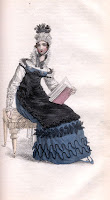
Loretta reports:
"When the Lent term of 1808 at Cambridge began, Byron was unable to return by reason of his debts. Scrope [Davies] chose not to do so and the two friends plunged into a life of dissipation in London. In Byron's case it was chiefly whoring and gambling; in Scrope's gambling and drinking. In his 'Detached Thoughts' Byron recalled one of Scropes more noteworthy achievements:
One night, Scrope Davies at a gaming house...being tipsy as he usually was at the Midnight hour, and having lost monies, was in vain intreated by his friends, one degree less intoxicated than himself, to come or go home. In despair, he was left to himself, and to the demons of the dice-box. Next day, being visited, about two of the Clock by some friends just risen with a severe headache and empty pockets (who had left him losing at four or five in the morning), he was found in a sound sleep, without a night-cap, and not particularly encumbered with bed-cloathes: a Chamber-pot stood by his bed-side, brim-full of--Bank Notes! all won, God knows how, and crammed, Scrope knew not where; but there they were, all good legitimate notes, and to the amount of some thousand pounds."
T.A.J. Burnett, The Rise & Fall of a Regency Dandy: The Life and Times of Scrope Berdmore Davies




.jpg) as the wire is twisted around the unsharpened end. The gold-toned pins are made of brass, with the advantage that they did not rust; the silver-toned ones are steel, which holds a sharper point than the brass, but rusts.
as the wire is twisted around the unsharpened end. The gold-toned pins are made of brass, with the advantage that they did not rust; the silver-toned ones are steel, which holds a sharper point than the brass, but rusts.










































